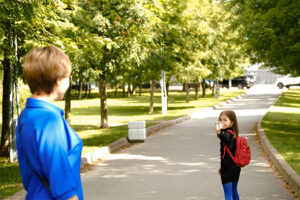Allergy & Immunology
Pediatric Food Allergies
Reducing the Risks of Accidental Food Allergen Exposure
Overview
Ensuring access to epinephrine is part of a multipronged strategy for risk reduction. Avoiding accidental exposures to food allergens requires a knowledge of where those allergens may be hiding, which scenarios pose the greatest risks, and how to best mitigate these risks when the child is in unfamiliar environments.
What are some of the best strategies to reduce the risks of accidental exposures to food allergens?
Aikaterini Anagnostou,, MD, PhD
|
|
“A variety of situations and environments should be considered high risk and require additional parental and patient education. This includes new or unfamiliar settings and travel, as well as open buffets in restaurants and other settings where foods are not labeled.”
Avoiding high-risk situations will reduce the risk of accidental exposures to food allergens, but these situations can vary depending on a child’s age. An example of a high-risk situation is when a young child is in a nursery facility with many other children who are all eating different foods, and cross-contamination or the infrequent cleaning of surfaces may be occurring. Parents need to make sure that the childcare facility is safe enough for very young children who are nonverbal and cannot advocate for themselves. Another age group (ie, teenagers) may also need particular attention because they are becoming more independent and may start taking risks.
A variety of situations and environments should be considered high risk and require additional parental and patient education. This includes new or unfamiliar settings and travel, as well as open buffets in restaurants and other settings where foods are not labeled. It is important that families and patients know about hidden allergens. Dieticians can be particularly helpful in this area because they are knowledgeable about food labeling, including labeling in different countries. For example, sesame was not labeled in the United States for a long time, but it was in Europe, which created confusion among those who were traveling.
Finally, to reduce the risk of accidental exposures, it is important to teach school-aged children, teenagers, and young adults to advocate for themselves. They should be confident—not embarrassed—about their food allergy. They need to be able to verbalize that they have a food allergy, and they should feel comfortable informing the staff or manager of a restaurant, for example, to ensure that they are aware. A similar approach would be needed for a school trip, where teachers and close friends should know about an existing food allergy.
It is important for anyone in the child’s close environment to be aware of their diagnosis so that, in the event of an allergic reaction, they can be of help. Families can get very good support from peer groups, patient charities, and advocacy groups. Patients find it helpful to meet others with similar diagnoses and benefit from their experience.
David M. Fleischer, MD
|
|
“The importance of the universal carriage of epinephrine is something that we emphasize and reiterate at every opportunity.”
Education is an important aspect of avoiding accidental exposures to food allergens, and it is an area that we, as allergists, can always improve. As Dr Anagnostou mentioned, dieticians are an amazing resource because they often know the products that may contain hidden allergens. They also know about foods that can be eaten as substitutes to ensure that their diet is nutritionally complete.
When accidental exposures occur, they are most often due to an unlabeled food (such as that from a restaurant or bakery), failure by the caretaker to carefully read a label, and, occasionally, a food that was not properly labeled. Other reasons include that they simply may not know how the food was made or that there was cross-contamination when a spoon that was mixed with a peanut or another allergen was used to prepare something that the child ate. When poor outcomes occur, there is often a failure to use epinephrine or a lack of access to it altogether. The importance of the universal carriage of epinephrine is something that we emphasize and reiterate at every opportunity.
In summary, children with food allergies need to avoid eating unless they are sure that the food is safe, either because they know for themselves that it is safe or because a parent told them that it is safe, and allergic patients must always have epinephrine with them.
Robert A. Wood, MD
|
|
“Children with food allergies need to avoid accidental exposures, but they also need perspective on what true risks are and what they do not really need to be worried about.”
Patients and families should be aware of the types of food that are more likely to include hidden ingredients that might cause allergic reactions or be cross-contaminated with another food. We know that most reactions to peanuts come from unlabeled foods from places such as bakeries and restaurants specializing in peanut-heavy cuisines, candies, and ice cream. So, there are certain places where people need to be particularly wary or that should be avoided altogether.
People need guidance on how to navigate eating at a restaurant, speak up, and ask the right questions. There is a general increasing understanding of food allergies, so patients may feel more comfortable, particularly in restaurants. However, if there is any uncertainty, it is best to just exit the establishment.
International travel is a unique situation, with language barriers and the different labeling protocols that Dr Anagnostou mentioned to contend with. Avoiding reactions becomes even more complicated during travel, but there are ways to minimize the risks. For teenagers and young adults, it is extremely helpful to provide them with guidelines about how to navigate all of the complicated day-to-day situations that may arise.
It is important to be aware of and to be able to identify what the real risks are. The risks associated with school cafeterias, for example, are, at times, overblown. And it is difficult to say whether peanut-free cafeterias and peanut-free tables have any real value. Further, many school-aged children are burdened with significant anxiety that may necessitate the involvement of psychologists and other professionals, as this anxiety can have an effect on day-to-day quality of life. Children with food allergies need to avoid accidental exposures, but they also need perspective on what true risks are and what they do not really need to be worried about.
References
Aydogan M, Topal E, Yakıcı N, et al. Food-induced anaphylaxis in early childhood and factors associated with its severity. Allergy Asthma Proc. 2021;42(5):e135-e144. doi:10.2500/aap.2021.42.210051
Boyce JA, Assa’ad A, Burks AW, et al. Guidelines for the diagnosis and management of food allergy in the United States: summary of the NIAID-sponsored expert panel report. J Allergy Clin Immunol. 2010;126(6 suppl):S1-S58. doi:10.1016/j.jaci.2010.10.007
Cherkaoui S, Ben-Shoshan M, Alizadehfar R, et al. Accidental exposures to peanut in a large cohort of Canadian children with peanut allergy. Clin Transl Allergy. 2015;5:16. doi:10.1186/s13601-015-0055-x
Greenhawt M. Environmental exposure to peanut and the risk of an allergic reaction. Ann Allergy Asthma Immunol. 2018;120(5):476-481.e3. doi:10.1016/j.anai.2018.03.011
Greenhawt M, Shaker M, Winders T, et al. Development and acceptability of a shared decision-making tool for commercial peanut allergy therapies. Ann Allergy Asthma Immunol. 2020;125(1):90-96. doi:10.1016/j.anai.2020.01.030













